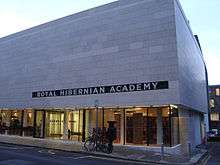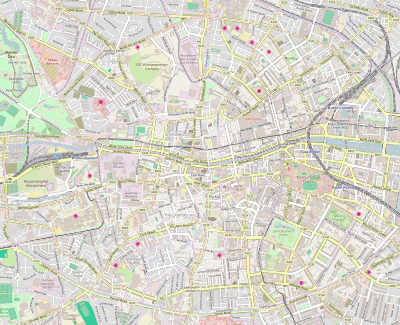Royal Hibernian Academy
The Royal Hibernian Academy (RHA) is an artist-based and artist-oriented institution in Ireland, founded in Dublin in 1823. In spite of Ireland gaining independence from the British Crown and becoming a Republic, the academy did not change its name.
 | |
 Location within Central Dublin | |
| Established | 1823 |
|---|---|
| Location | 15 Ely Pl, Dublin 2, Ireland |
| Coordinates | 53.337076°N 6.2568907°W |
| Type | Art gallery, Art studios |
| Director | Patrick T. Murphy |
| Curator | Ruth Carroll |
| Public transit access | Stephen's Green Luas stop (Green Line) |
| Website | www |
History
The RHA was founded as the result of 30 Irish artists petitioning the government for a charter of incorporation. According to the letters patent of 5 August 1823, The Royal Hibernian Academy of Painting, Sculpture, and Architecture was established, which included a National School of Art.[1] The first elected president was the landscape painter, William Ashford. In 1824 architect Francis Johnston was made president. He had provided headquarters for the RHA at Academy House in Lower Abbey Street at his own expense.[2] The first exhibitions took place in May 1825 and were held annually from then on. To encourage interest in the arts works displayed at the RHA were distributed by lot as prizes among subscribers. Works by Frederick William Burton, Daniel Maclise, J. M. W. Turner and David Wilkie, among others, were presented in this way. The exhibitions and school prospered and by the end of the 19th century the RHA was the leading Irish institution involved in promoting visual arts. Academy House was destroyed by fire in 1916 during the Easter Rising.[3]
In the middle of the twentieth century the RHA was seen as reactionary, hindering the development of modernism in Ireland and the Irish Exhibition of Living Art was founded 1943 to challenge the RHA's own exhibition policies . This has changed again, Louis le Brocquy one of the founders of the Irish Exhibition of Living Art was a member of the Honorary Council of the Academy and the RHA's own mission statement states that it is dedicated to developing, affirming and challenging the public's appreciation and understanding of traditional and innovative approaches to the visual arts.
In 1970 the RHA constructed a new building in Ely Place in Dublin. The building was closed between 2007–09 for renovations.[4] This building houses six galleries; here the Academy mounts the annual exhibition. In addition, the Academy curates frequent exhibitions and frequently is responsible for major retrospectives of the work of Irish artists. The Academy has a large collection of Irish art, but this is not on display.
The Academy is funded by: the Arts Council of Ireland (An Chomhairle Ealaíon), through revenue from its Annual Exhibition, and from Benefactors, Patrons and Friends of the Academy.
On the weekend of 7–8 March 2009, an unknown person placed satirical naked paintings of Brian Cowen in the National Gallery of Ireland and the gallery of the Royal Hibernian Academy.[5] The painter was subsequently discovered to be Conor Casby.[6] This caused some controversy at the time, as the matter was investigated by the Gardaí, and the state broadcaster RTÉ was forced to apologise for showing the pictures in a news broadcast.
Selected exhibitions
The RHA has held an annual exhibition – an open submission art show – since 1826. It is "the largest in Ireland and the longest-running".[7]
FUTURES (originally EuroJet Futures) is an ongoing series of exhibitions featuring selected emerging artists from Ireland. It began in 2001 and has had three series – each with annual exhibitions. Additionally each series has had an 'anthology' presenting all of the artists from that series together.[8][9][10]
Letters after the name
There are three instances of post-nominal letters used by Academicians.[11]
- RHA, Royal Hibernian Academician
- HRHA, Honorary Member of the Royal Hibernian Academy
- PRHA, President of the Royal Hibernian Academy
See also
References
- Wright, George Newenham (1825). An Historical Guide to the City of Dublin. Baldwin, Cradock, and Joy. p. 239.
- de Courcy, J.W. (1996). The Liffey in Dublin. Gill & Macmillan. p. 468. ISBN 0-7171-2423-1.
- McCormack, W.J. (2001). The Blackwell Companion to Modern Irish Culture. Wiley-Blackwell. p. 205. ISBN 978-0-631-22817-2.
- McDONALD, FRANK. "Renovated RHA building a real work of art". The Irish Times. Retrieved 2019-10-29.
- Naked taoiseach paintings removed
- Today FM producer brands reaction ‘crazy’
- Coyle, Dominic. "Sales dip at RHA's annual exhibition". The Irish Times. Retrieved 2019-10-29.
- "The Anthology Exhibition". RHA. 2013-12-02. Retrieved 2019-10-29.
- "FUTURES Anthology". RHA. 2015-05-06. Retrieved 2019-10-29.
- Dunne, Aidan. "High anxiety and the fine art of falling apart". The Irish Times. Retrieved 2019-10-29.
- "Catalogue" issue 80 page 7. Royal Scottish Academy. 1906. Retrieved Google Books 2017-06-07.
Further reading
- MacLeod of MacLeod, Norman (28 May 1858). Report upon the affairs and past management of the Royal Hibernian Academy. Parliamentary Papers. Session 1857-58, Vol. XLVI, No.294.
- Memorial and Statement of Treasurer of Royal Hibernian Academy to Lord Lieutenant of Ireland, September 1865; Report from Eyre Crowe on Royal Hibernian Academy's Schools of Art. Parliamentary Papers. Session 1866, Vol. LV, p.221. 10 August 1866.
- Royal Commission on Science and Art Department in Ireland (1869). Vol.1: Report. Parliamentary Papers. Session 1868-69, Vol. XXIV, p.1.
- Royal Commission on Science and Art Department in Ireland (1869). Vol.2: Minutes of evidence, Appendix, &c. Parliamentary Papers. Session 1868-69, Vol. XXIV, p.43.
- Committee of Enquiry into the Work carried on by the Royal Hibernian Academy and Metropolitan School of Art, Dublin (1906). Cd.3256: Report with minutes of evidence, appendices, and index. Parliamentary Papers. Session 1906, Vol. XXXI, p.799. Dublin: HMSO.